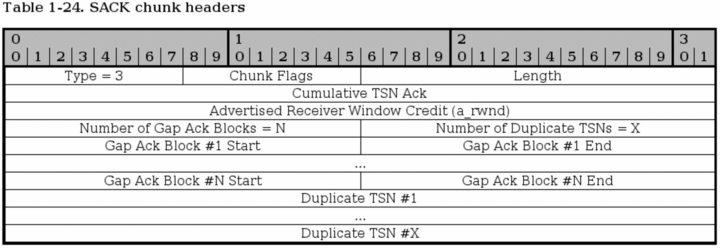Книга: Iptables Tutorial 1.2.2
SCTP SACK chunk
SCTP SACK chunk

The SACK chunk is used to tell the sender of DATA chunks which chunks has been received and where there has been a gap in the stream, based on the received TSN's. Basically, the SACK chunk acknowledges that it has received data up to a certain point (the Cumulative TSN Ack parameter), and then adds Gap Ack Blocks for all of the data that it has received after the Cumulative TSN Ack point. A SACK chunk must not be sent more than once for every DATA chunk that is received.
Type - bit 0-7. This header is always set to 3 for SACK chunks.
Chunk flags - bit 8-15. Not used today. Might be applicable for change. See SCTP Common and generic headers for more information.
Chunk Length - bit 16-31. The chunk length is the length of the whole chunk, including everything in the headers and all the parameters.
Cumulative TSN Ack - bit 32-63. This is the Cumulative TSN Ack parameter, which is used to acknowledge data. The DATA chunk receiver will use this field to tell the sending host that it has received all data up to this point of the association. After this point, all data that has not been specifically acknowledged by the Gap Ack Blocks will, basically, be considered unaccounted for.
Advertised Receiver Window Credit (a_rwnd) - bit 64-95. The a_rwnd field is basically the same as the a_rwnd in the INIT and INIT ACK chunks, but can be used to raise or lower the a_rwnd value. Please read more in the RFC 2960 - Stream Control Transmission Protocol document about this.
Number of Gap Ack Blocks - bit 96-111. The number of Gap Ack Blocks listed in this chunk. Each Gap Ack Block takes up 32 bits in the chunk.
Number of Duplicate TSNs - bit 112-127. The number of DATA chunks that has been duplicated. Each duplicated TSN is listed after the Gap Ack Blocks in the chunk, and each TSN takes 32 bits to send.
Gap Ack Block #1 Start - bit 128-143. This is the first Gap Ack Block in the SACK chunk. If there are no gaps in the received DATA chunk TSN numbers, there will be no Gap Ack Blocks at all. However, if DATA chunks are received out of order or some DATA chunks where lost during transit to the host, there will be gaps. The gaps that has been seen will be reported with Gap Ack Blocks. The Gap Ack Block start point is calculated by adding the Gap Ack Block Start parameter to the Cumulative TSN value. The calculated value is the start of the block.
Gap Ack Block #1 End - bit 144-159. This value reports the end of the first Gap Ack Block in the stream. All the DATA chunks with the TSN between the Gap Ack Block Start and the Gap Ack Block End has been received. The Gap Ack Block End value is added to the Cumulative TSN, just as the Start parameter, to get the actual last TSN of the block chunks to be Acknowledged.
Gap Ack Block #N Start - bits variable. For every Gap Ack Block counted in the Number of Gap Ack Blocks parameter, one Gap Ack Block is added, until the final N block. Ie, if Number of Gap Ack Blocks = 2, then there will be two Gap Ack Blocks in the SACK chunk. This is the last one simply, and contains the same type of value as the Gap Ack Block #1 Start.
Gap Ack Block #N End - bits variable. Same as for the Gap Ack Block #N End, but for the end of the gap.
Duplicate TSN #1 - bits variable. These fields report a duplicate TSN, in which case we have already received a specific chunk, but receive the same TSN several times more. This can either be router glitches (retransmitting already sent data) or a case of retransmission from the sending endpoint, or a score of other possibilities. Each instance of a duplicate TSN should be reported once. For example, if 2 duplicate TSN's has been received after acknowledging the first one, each of these duplicate TSN's should be sent sent in the next SACK message that is being sent. If even more duplicate TSN's should appear after this second SACK is sent, the new duplicates should be added in the next SACK, and so on.
Duplicate TSN #X - bits variable. This is the last duplicate TSN parameter, containing the same type of information as the first parameter.
- SCTP Generic header format
- SCTP Common and generic headers
- SCTP ABORT chunk
- SCTP COOKIE ACK chunk
- SCTP COOKIE ECHO chunk
- SCTP DATA chunk
- SCTP ERROR chunk
- SCTP HEARTBEAT chunk
- SCTP HEARTBEAT ACK chunk
- SCTP INIT chunk
- SCTP INIT ACK chunk
- SCTP SACK chunk
- SCTP SHUTDOWN chunk
- SCTP SHUTDOWN ACK chunk
- SCTP SHUTDOWN COMPLETE chunk




